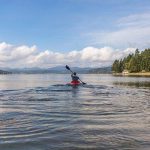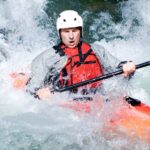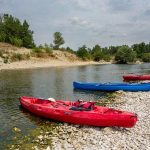Kayaking is a well-known form of boat navigating that attracts many people. The sight of experts maneuvering around obstacles and moving smoothly in the water makes it clear why it’s such a preferred activity.
With the proper paddling methods, you can traverse extensive areas and discover distant rivers and lakes.
In this article we are going to look at the best way to get into kayaking, plus some useful tips and tricks…
How to Kayak For Beginners
If you’re just getting into kayaking, it’s best to take it slow. Consider renting the equipment to see if you enjoy the sport or take a beginner’s class.
Having a good understanding of the fundamentals allows you to gain a greater appreciation for a sport and to make sure you are willing to invest in it.
Kayaking, is it difficult?
Kayaking is an ideal sport for beginners as you can quickly jump in and begin having fun once you have grasped the fundamentals. Approximately, if you venture into choppy waters and hostile conditions, it could be hazardous. Moreover, it is not recommended for experienced kayakers.
List for kayaking:
Here is the list of items to take with you on your first kayaking adventure:
- A kayak and a paddle (unless you hire them).
- A waterproof bag: in which you will slip your things and which will be stored in the box.
- A water bottle: to hydrate yourself, place it in the kayaking box or between your feet.
- A life jacket: it’s an obligation, no exceptions.
- Extra clothes: Always remember to pack extra layers if the weather changes.
- A kayak carrier: if you have your own kayak, it should be easily transported to your destination. We have provided a guide to help you choose the best kayak carrier for your car.
What outfit to wear for kayaking?
It is important to dress in layers in order to maintain warmth. Here is how to multiply the layers and which materials to favor:
- Base layer: Opt for a short-sleeved t-shirt if it’s hot, but always have a long-sleeved t-shirt handy just in case. Choose synthetic materials, such as polyester and polypropylene, which stay warm even when damp.
- Mid-layer: a fleece jacket or thicker polyester fabric is best.
- Waterproof vest: take the most waterproof vest possible, one that keeps you dry.
Leggings and shorts: If it’s cold, opt for polyester leggings and waterproof shorts. If it’s hot, take the leggings just in case.
Wetsuit or wetsuit? People who are experienced kayakers are often asked what type of wetsuit they recommend for that activity and the answer is none!
Wetsuits are designed to keep you insulated and warm while in the water. Kayaking is an activity done on the water, so the wetsuit can get chilly and hinder movement.
In the end, the perspiration built up beneath the suit provides a suitable habitat for microorganisms, which is not ideal.
The best choice is the drysuit. Any waterproof or waterproof clothing is suitable. If you are just starting out kayaking, a drysuit is preferable, however the garments you already have in your closet should be sufficient.
Wear clothing suitable for swimming and be prepared for changes in the temperature. Clothe yourself in a way that will keep you warm if you end up in the water. The danger of hypothermia is a serious concern even when the temperature outside is high, because the water can be extremely chilly.
Be sure to pack extra clothing or layers in the kayaking box in case the weather turns unexpectedly.
The different parts of a kayak
The names of the different parts of a kayak may leave you confused if you’ve never heard of them before, but the basics are pretty straightforward:
- Bow: the front part of the kayak
- Stern: the rear part of the kayak
- Deck: upper part of the kayak (this term is known)
- Hatch: The compartments below the kayak deck allow you to store food, extra clothing or gear to keep dry.
- Rudder: fin located at the end of the kayak that comes into contact with the water to help the kayak go in the right direction.
- Bungee cords: elastic ropes located on the deck to store more equipment.
- Cockpit: opening where you are seated.
- Footrests: sometimes also called footrests, adjustable elements on which you put your feet.
- Thigh braces: plastic hooks set back from the cockpit of your kayak and which allow you to wedge your thighs against the kayak.
How to get on a kayak?
The ideal spot for beginning a kayaking expedition is a beach with sand. Sit in the kayak and propel yourself forward with your hands.
From the dock: take the kayak to the lowest point of the dock because the higher you are, the more difficult it is to board.
- The kayak should be parallel to the dock.
- Support yourself on the dock with both hands and, with one quick movement, place your feet in the kayak and turn so that you are facing the bow.
- Sit down as quickly as possible in the cockpit.
- As soon as you are in a sitting position, you will regain your balance and better position your feet later.
In the water:
If you desalinate, be sure to turn the kayak upside down to prevent it from filling up with too much water.
- Find your paddle and store it in the bungee cords to keep it safe.
- With one hand gripping either side of the cockpit, kick for the momentum and push up
- Lie face down on the kayak. Concentrate on the sitting position first, as this will help you keep your balance.
- Turn around and slide into the seat.
- Then tuck your feet in. Practice in shallow water before heading out to sea.
How to paddle?
How to hold the paddle?
Grasp the paddle at a distance of about 6 inches from the edge, keeping your hand loose but adequately in control. Your fingers’ knuckles should be placed in a row with the final part of the paddle blade.
One way to ensure you are doing the proper activity is to raise the paddle above your head. If your elbows are bent at a ninety-degree angle, you are holding the paddle properly.
Movements
To advance, rotate your body in the opposite direction as the one you intend to paddle in. Insert the paddle into the water and rotate your torso and limbs, utilizing the momentum produced by the rotation to propel you forward.
The paddle should be removed from the water when the nearest hand is positioned at your waist. The one in a higher position should continue to put forth effort, while the one in a lower position should persist in drawing back.
It is advised that the power to move the kayak ahead should come from the rotation of your torso, not your arms.
Go forward while making a large turn, emphasizing one side. Place the oar a considerable distance ahead of the canoe and stroke in an extensive arc, completing the cycle until the paddle is near the back of the boat.
Move away from the place you intend to go to in a large arc. Turn only one side while doing this action. To successfully perform a turn with forward momentum, initiate a wide rotation in the opposite direction of where you intend to go and complete it with a regular turn on the other side.
Kayaking or canoeing
Both kayaking and canoeing let you to take in the beauty of nature from the water. If you are thinking of beginning a sport involving water, pick the one that most closely aligns with your vision of a natural experience on the water.
The canoe :
- Designed for multi-day trips due to its large size and because it can carry more stuff.
- Indicated for families since it is possible to settle there with two parents + children.
Paddling in Windy Conditions
Taking a kayak trip in Javea means being in the middle of the ocean, so it is likely that we will encounter varying levels of wind, ranging from light to forceful. The wind may have an influence on your kayak.
However, there’s no need to be alarmed. It is merely par for the course, and you can correct it easily if you’re properly informed.
You should always try to have your kayak lined up with the wind whilst paddling, irrespective of if you are moving towards the wind or slipping along with it, so you can save energy. This will result in the best route to take during your kayaking trip, helping you preserve and conserve energy.
You will find that gusts of wind will be able to push your kayak off balance and tilt it if they come from the side. This is why it is imperative to always paddle in the same direction as the wind.
In the event that this occurs, the only thing you have to do is incline your kayak slightly against the gust to balance out the extra power exerted on it.
Don’t worry if you are unable to stay in command; this is common! It is critical to keep calm, take a deep breath, and get yourself back on track! Nevertheless, if you adhere to the advice and strategies, you will never confront this problem!
What Do I Do if I Fall in The Water and Capsize During my Kayaking Excursion?
Although Siesta Advisor provide some of the most reliable kayaks available, there is a slight possibility that your kayak might overturn and overturn while you are taking a kayak tour. If this happens, don’t worry, it’s completely normal.
Your life preserver will always ensure you stay above water, the paddles we give you can’t sink either, and of course, the kayak will remain buoyant!
The worst thing that could potentially happen if you capsize is a personal belonging, such as sunglasses, falling out of the kayak and sinking to the bottom of the water!
We suggest that you make sure everything is properly locked away and secured while kayaking. Even if an item sinks to the bottom of the lake, our kayak monitors have a lot of practice with freediving, usually making it possible to bring back whatever was lost! It’s prudent to be observant and evade any potential risks.
Back to the capsizing… once you are in the water, simply flip your kayak back over, something you shouldn’t have an issue with, and once the kayak is upright properly, just follow the steps below:
1. First, put one hand on handle of the kayak’s side closest to you, and put your other hand on the opposite side handle – so your arm will be extended across the kayak and above the seat.
2. Pull yourself up onto your kayak so that your belly button is over the seat. Your legs will still be about halfway in the water.
3. Next, twist around to get your bottom on the seat. Your legs will still be dangling in the water, but you should have most of your body in the kayak now.
4. Make sure the kayak is stable, pull your feet in and put them in front of you.
5. If you are in a double kayak, make sure that the other person occupying the kayak is putting counter-weight onto the other side of the kayak, helping you climb in!




